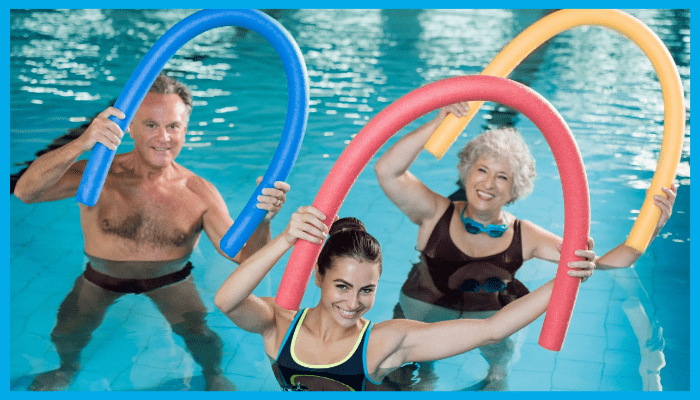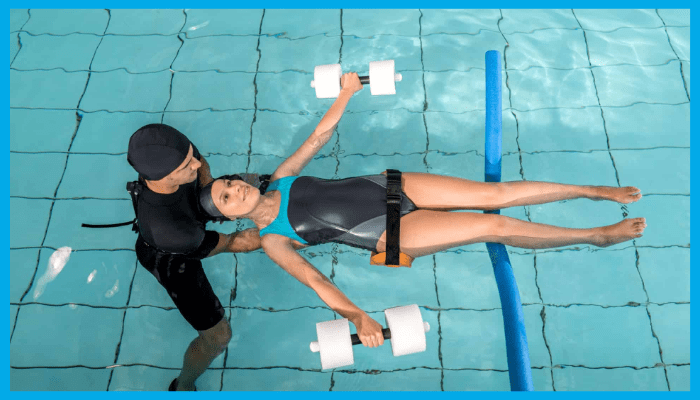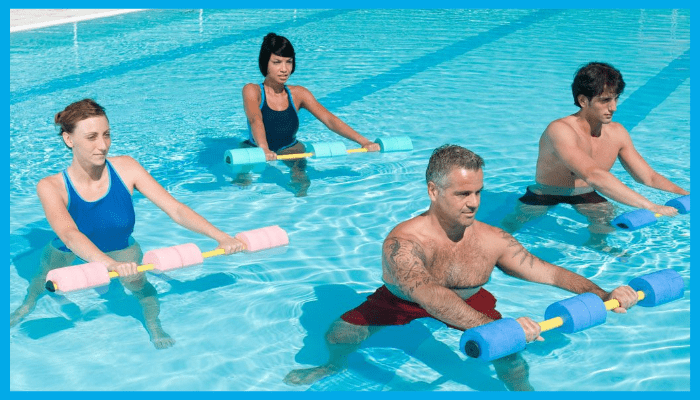8 Ways Aqua Aerobics Helps With Injury Recovery and Rehabilitation
Recovering on land can feel risky if your joints ache. That’s why many people choose
aqua aerobics.
It’s a safer, more supportive option for injury recovery and rehab exercises.
In warm, waist-high water, you'll move with less pain and gain confidence back.
This guide presents 8 ways these exercises reduce joint load, restore mobility, and rebuild strength. Canberra's year-round indoor pools support your journey from relief to resilience.
Why Water Works for Rehabilitation
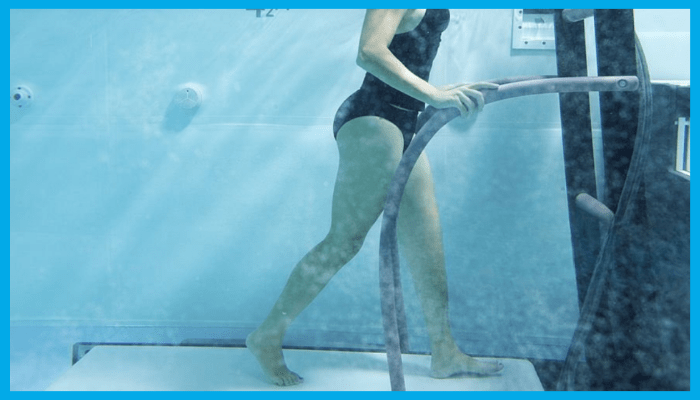
The aquatic therapy environment works brilliantly for healing. Hydrostatic pressure helps circulation and reduces swelling. Buoyancy makes the body feel lighter on joints.
Natural resistance strengthens muscles with every movement. Water walking and deep water
exercises boost heart health. They do this without putting stress on your joints, unlike land-based workouts.
Better Health Channel and Healthdirect Australia conducts a systematic review and thorough research on this.
Aquatic exercise improves mobility, balance, and recovery, particularly for musculoskeletal issues and arthritis.
At Aquatots, every session happens in a genuinely safe and supportive aquatic environment. This allows participants to exercise confidently whatever their age or fitness level.
Who Benefits (and When to Check With a Clinician)
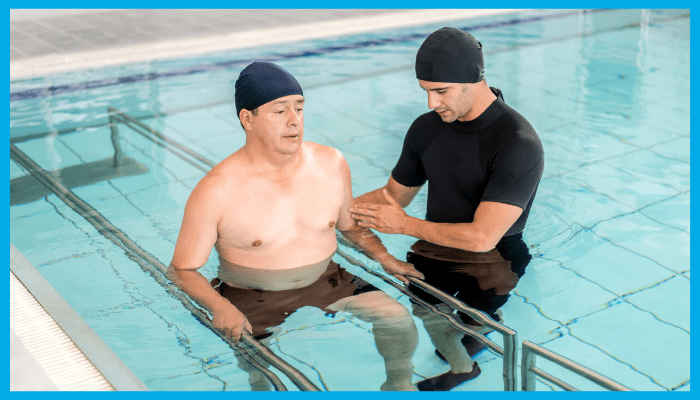
Aqua aerobics proves beneficial for:
- Knee, hip, and shoulder injuries.
- Chronic conditions including arthritis and osteoporosis.
- Post-surgery recovery, especially joint replacements.
- One of the major
benefits of aqua aerobics for seniors is better balance and mobility, helping reduce fall risk while improving confidence in movement.
If you have heart disease, open wounds, chronic conditions, or recent surgery, check with a physical therapist first. They'll ensure you train in a safe environment that properly supports recovery.
Getting Ready: Equipment, Depth & Technique Equipment
Equipment
- Water shoes give you grip on the pool floor.
- Noodles, paddles, or dumbbells help create resistance at different depths
Depth & Setup
- Begin in waist high water; advance to deep water with a floatation belt.
- Use the pool wall or pool edge for support and stability, technique, and hydration.
Technique & Hydration
- Check starting position: chest level posture, knees straight, core engaged, toes facing forward.
- Stay hydrated: drink plenty of water before, during, and after sessions.
The 8 Ways Aqua Aerobics Accelerates Recovery
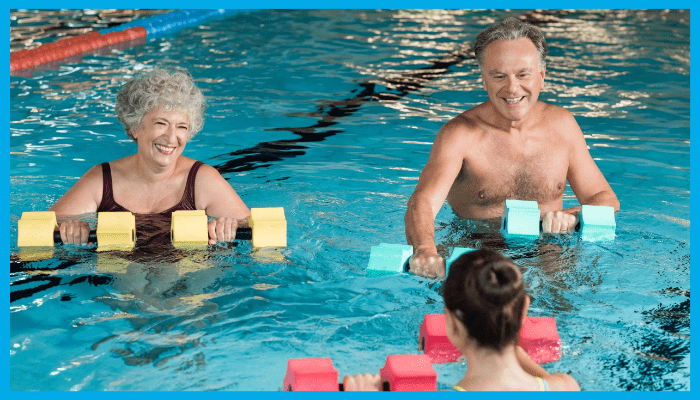
1. Reduce Pain and Stiffness (Phase 1: Relief)
Short sessions of water walking and gentle movements with less resistance calm irritated joints and muscles. Hydrostatic pressure naturally supports pain relief.
2. Restore Mobility and Range of Motion
Wall assisted hip swings, arm raises, and shallow squats expand range safely. Slowly lower into positions that feel comfortable.
3. Build Core Strength Without Strain
Wall supported plank position drills engage stabilising muscles. Keep hands shoulder width, palms facing down.
4. Rebuild Lower Limb Strength
Walking forward in waist high water, using body weight and squats on the pool floor build leg strength. Lead with one knee, keep the other leg soft, knee straight when extending.
Start rehabilitation gently with aqua aerobics classes in Canberra or contact our swim school to book your first session.
5. Improve Balance and Proprioception
Single leg holds at the pool wall; switch legs every 30 seconds. The aquatic environment reduces falling risk.
6. Low Impact Cardiovascular Fitness
Wearing water shoes, intervals of water walking, jogging at chest level, or deep water running with a belt boost endurance without joint stress.
7. Upper Body Strength and Posture
Push and pull drills with paddles or dumbbells strengthen arms, shoulders, and back. Add faster movements only when pain free.
8. Build Long Term Resilience (Phase 3: Resilience)
Make pool exercises your weekly habit. Combine water-based exercises with gradual land training for many benefits.
This approach lowers the risk of re-injury and supports lifelong mobility.
For practical tips, explore our other health and fitness articles including the benefits of water aerobics.
Technique Library: Quick How-tos
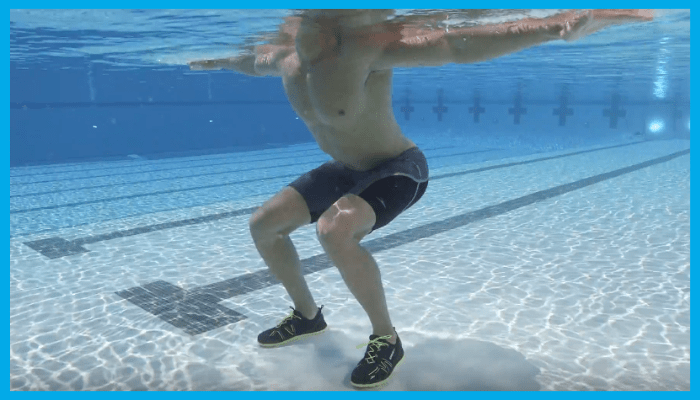
- Water walking: 3 to 5 minutes warm up; upright chest level posture; natural arm swing.
- Wall squats: 2 to 3 sets of 8 to 10 reps; knees straight on rise; slowly lower with control.
- Standing rows: 2 sets of 10 to 12 reps; hands shoulder width; palms facing each other.
- Deep water running: 4 to 6 intervals of 30 to 45 seconds; belt on; slight lean forward.
Programming Examples.
- Beginner (Relief): 20 to 25 minutes, RPE 3 to 4, twice weekly; mobility plus cardio.
- Rehabilitation: 30 to 35 minutes, RPE 4 to 6, 2 to 3 times weekly; add strength and balance.
- Resilience: 40 minutes, RPE 5 to 6, 3 times weekly; integrate intervals, resistance drills, and 1 to 2 land based sessions.
Conclusion
Start your rehabilitation gently with aqua aerobics and feel the difference water offers. Many people also compare aqua aerobics vs. swimming for fitness, but when it comes to recovery, aqua aerobics provides the safe, low-impact environment your body needs.
For bookings and enquiries, contact our swim school or call
02 6162 0507 to get started.
Frequently Asked Questions
Is Aqua Aerobics Good for Injury Recovery?
Absolutely. The aquatic environment helps reduce joint load. It supports mobility and boosts cardiovascular fitness. Plus, it poses less risk than land based training exercises.
What Are the Best Pool Exercises for Knee Rehabilitation?
Water walking, wall supported squats, and step drills on the pool floor with knees straight work brilliantly and safely.
How Often Should I Do Aqua Aerobics for Rehab?
Start with 2 to 3 sessions weekly, 20 to 35 minutes each. Increase resistance gradually using tempo, equipment, or faster movements.
Is Deep Water Running Suitable for Rehabilitation?
Yes! With a floatation belt, deep water exercises give you cardio benefits with minimal joint load.
Do I Need a Physical Therapist Before Starting?
Talk to a physical therapist before starting aqua aerobics if you’ve had surgery, heart disease, or chronic conditions.
Can Older Adults Benefit From Aqua Aerobics?
Definitely. It's a safe place. Older adults can improve balance, strengthen muscles, and build core strength effectively with regular physical activity. Especially when using aqua aerobics for injury recovery and rehabilitation exercises.

